|
Supermarine Spitfire IXc
Kits Compared
by Bruce
Archer
|

|
|
Supermarine Spitfire IXc Kits
from top left clockwise: Ocidental, ICM, MPM, and Hasegawa |
For a model
company to mold and manufacture a Spitfire model kit they must be brave enough
to sprint through the minefield of intense scrutiny. Fans of the Supermarine
Spitfire/Seafire tend to be hard-nosed, diehard, take-no-prisoners type of loyal
supporter who have no parallel in the modeling world. When a new kit of any mark
is released, these fans measure it, then re-measure it, and measure it again.
Then the comparisons between the kits start, and they never seem to stop. The
commentary on these kits seems to go on and on.
The purpose of
this article is not to go into the history of Supermarine’s Masterpiece. There
is not enough space to do so. I will therefore leave the history to those who
write so much better than I such as Dr. Alfred Price. Instead, the intent is to
compare the three latest 1/48th scale renderings of the Spitfire
Mk.IXc in plastic: the ICM, Ocidental, and the newest Hasegawa. I have not
included the Monogram Mk. IXc nor the Otaki/Arii/Airfix Mk.VIII/IX . These kits
suffer from fatal, hard to correct shape errors and are not molded as nicely as
the latest three kits. These two kits also suffer from major detail omissions
and inaccuracies. Both kits are best left to the collector. I have also not
included Spitfire Mk. VII, VIII, IXe, or XVI, as I wish to compare navel oranges
to navel oranges and not navel oranges to juice oranges.
The main
players, ICM, Ocidental, and Hasegawa have been measured and commented on. There
has been some comparison, but in prose only. The purpose of this article is to,
hopefully, put all this information in one place so the modeler can make up his
or her mind as to which kit they would prefer to build.
By explaining
how I compared each kit to the others, I hope the reader will better understand
the comparisons.
First of all a
really good set of plans was necessary. The plans I used were found in
“Spitfire: The Canadians” by Robert Braken and drawn by A. R. Clint. These plans
appear to be the most accurate in print. These plans were read directly, and
were not enlarged to avoid any parallax effect distortion from the enlarging
process. Certain kit parts were measured using a rule which was graduated in
both 1/48th scale feet and in millimeters. The measurements were
compared to measurements from the plans, measurements done by Olav Hunges and
measurements I took of Spitfire Mk.VIII, MT417 of the Cavanaugh Museum in Texas.
A table containing some of these measurements is attached at the end of this
article.
One of the
failings of most the commentators is the lack of visual comparisons between the
kits. I therefore taped each part, or laid each part next to it counterpart. I
then took a digital image. This graphically illustrated the differences between
each kit. As this article was intended to concentrate on the general overall
shape, I glossed over the detailing of these three kits. And finally the
optional parts and decals from each were compared.
Remember the
views expressed are mine, and mine alone.
|
Spitfire IX Kits in 1/48 Scale |
Ocidental and MPM Spitfire IXc
When Ocidental
announced the pending release of their Mk.IX, there was a sense of joy as a
mainstream manufacturer was going to do a Mk.IX. Joy soon turned to
disappointment as Ocidental had made a major mistake with the nose of the Mk.IXe
kit. This kit was then thoroughly trashed as being fit only for the scrap box.
This criticism was way too harsh. When Ocidental released their Mk.IXc and the
Mk. XVI, kits they made an attempt to fix the nose.
The Ocidental
Mk. IXc is a simple kit, but has a few omissions and errors in shape. Though an
attempt was made to fix the nose, it still is not quite right. The tail wheel is
oversized and the wheels and tires are bland as are the radiators and cockpit
interior. The spinner will need replacement. The wings appear to be in scale.
However the trailing edge is a little too rounded due to the chord being too
broad at he widest part of the wing, and the roots will have to be filed so the
wing will have the correct dihedral. Most of the errors and oversights can
easily be corrected with a file and some of the many resin parts that have been
produced for this kit. Ron’s Resins and Aeroclub are two of the manufacturers
that come to mind. However the list price of $30.00 ( US )is a drawback.
All is not lost
with this Mk.IXc. The kit is basically in scale, and the shape is acceptable (
with the exception of the nose). The kit is reasonably easy to build. With the
few corrections mentioned the kit builds into a nice model.
The MPM MkIXc/e
is the Ocidental IXe with different decals and a bag of resin parts and sells
for less than the original kit.
ICM
Even more
anticipated than the Ocidental kit was the ICM series of Spitfires. These,
however, had a very shaky start. Quality control was lacking which led to
packaged kits missing sprues, having short shots, lots of flash, and, one of the
kits I purchased was the wrong kit in the right box (or the right kit in the
wrong box?). ICM however cheerfully replaced parts, sprues and entire kits when
asked.
There are a lot
of parts packed in the flimsy cardboard box. The nose of this kit has been
over-engineered to have a Merlin engine, the source of most of these parts. This
is not fatal though. The nose has the correct shape to it. The main flaws with
this kit are the potential for excessive flash, short shots, and missing
sprues(though these problems seem to have been fixed) and sink marks.
Additionally, the undercarriage is a bit long, the wheels need replacing, as do
the prop and spinner. Plus that multi-piece nose is a pain to assemble.
All of that
aside the ICM kit scales out almost perfectly. The panel lines are fine and the
actual molding of the kit is improving constantly. The IXc kit has a plethora of
optional parts (cannon bulges, stabilizers, armaments, and such), a set of very
nice bomb racks, a fairly nice interior along with 6 decal options. The kit has
an accurate outline which makes it very attractive.
Hasegawa Spitfire IXc
After the
quality control problems with the ICM kit, the Hasegawa Mk.IX was eagerly
anticipated even more than the ICM Mk.IX . With Hasegawa’s recent releases it
was assumed that this kit would be the ultimate Mk.IX kit. Reviewers have sung
the praises of this kit in more than one forum. Though molded very nicely
something does not look right with the kit. When compared to the ICM and
Ocidental kits, it is evident that the Hasegawa kit is too short in length. This
throws off where the wing (which is in scale!) sits on the fuselage, making the
taper from the cockpit to the rudder too pronounced. And the spinner is too
long. The Hasegawa kit looks decidedly odd. The molding, a beautiful interior
and a good prop cannot help the kit.
Whereas the
faults in the Ocidental and the ICM kits are easily corrected with a spot of
filler, some sanding or a few resin pieces, the Hasegawa’s faults are extremely
difficult to fix and therefore fatal.
All
three of these Spitfire MkIX kits come with some extra parts. The amount ranges
from a few parts in the Ocidental and Hasegawa kits to a lot of parts in the ICM
and the re-boxing of the Ocidental kit by MPM.
Ocidental
The
Ocidental MkIXc has few options included. You get wing and centerline bomb
racks with two 250 lb. and one 500lb. bombs, and the early and late “C” wing
bulges. The bomb racks are fairly basic. Only two decal options are given.
MPM
The MPM
boxing of the Ocidental Mk.IXe contains all of the Ocidental pieces along with a
bag of resin parts which include: clipped wing tips, an early intake, early
stabilizers, early and late “C” wing bulges, “E” wing bulges, new tires, 3,4,5
and covered spoke wheels, and a set of “C” wing cannon. These are in cream
colored resin and are done really well. MPM also includes a decal sheet with 5
options, which including early to late “C” and “E” winged aircraft.
Hasegawa
Hasegawa is not as generous as MPM. It does come with the Mk.VIII tail wheel,
doors and wheel well, three sets of cannon, two sets of exhausts, and a nice set
of wing bomb racks. Only two decal options are provided, and both of these are
wrong.
ICM
Oh boy
if you like extra parts you will love this kit! Parts include: early and late
tailplanes, early and late “C” bulges, early, late and MkVII style intakes, two
sets of cannon fairings, wing and centerline bomb racks (very nice!), two sets
of cowling sides, standard and clipped wing tips, a pressurization intake,
rockets and rails, a 75(?) gallon slipper tank, a slightly underscale Merlin
engine, .50 cal. machineguns, 20mm cannon, and decals for 6 aircraft.
There
have been lots of comments made about all three of these kits. But no one has
directly compared them to each other. So here we go…
ICM
Compared to Ocidental
When
taped together it was found that the two fuselage halves were practically the
same length. The wing was located in the same area as were the tailplanes. The
front edges of the cockpits matched with each other, but the windscreen, canopy,
and backlite all seemed to be a bit longer in the ICM kit.
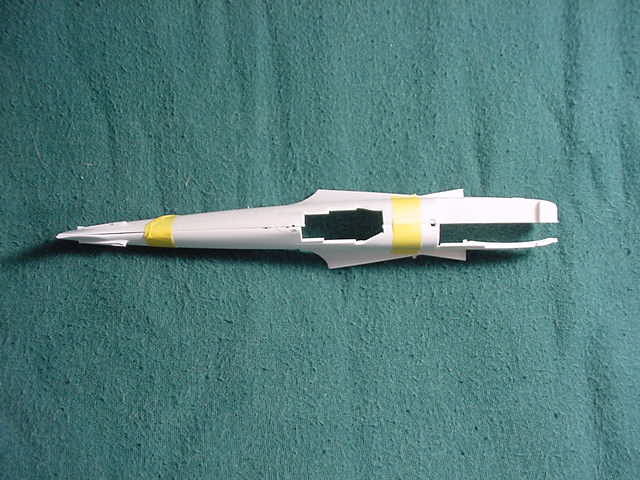 |
|
ICM and Ocidental, ICM at the
bottom. This shows the similar length and differences with the cockpits. |
The
thrust lines of both the Ocidental IXc and IXe are about 2mm too low. Both the
Ocidental and ICM fuselage halves match very well along the rear, from the
cockpit to the tail .
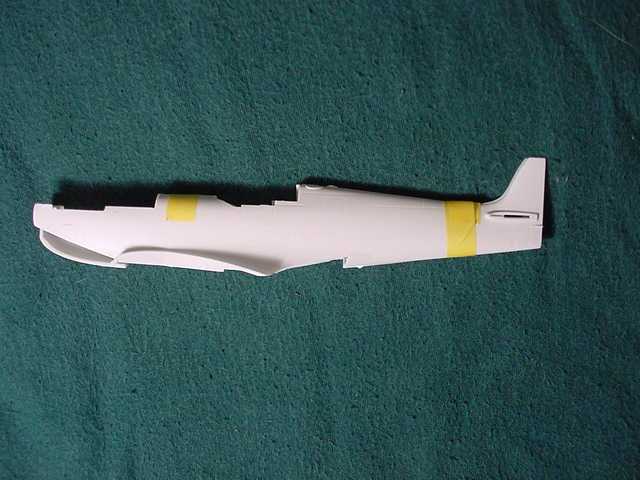 |
|
ICM and Ocidental with the
ICM on top. This image shows the similarity in fuselages |
The ICM
has a wing span of 37feet 9 inches, and the Ocidental has a wing span of 37
feet. The actual wing span is published to be 36 feet 10 inches. The ICM wing
has the better shape, due to the Ocidental wing being a bit too broad in chord
at the thickest point .
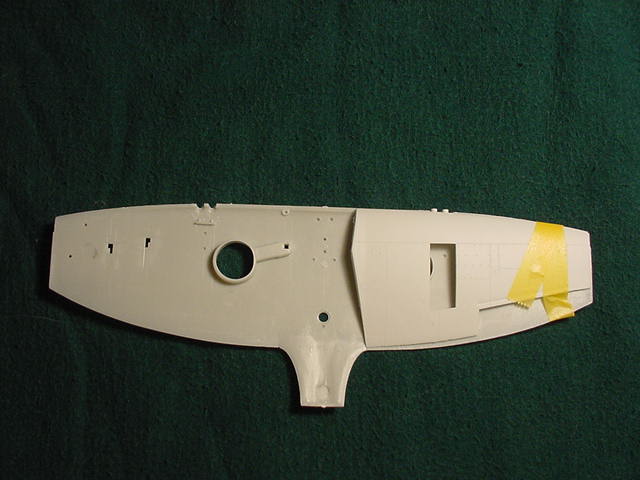 |
|
ICM and Ocidental, with ICM on
top. This shows the Shapes of the two wings. The Ocidental is too broad. |
The
Ocidental rudder tends to be slightly more rounded, and has a better shape.
Ocidental has better propeller blades, and ICM the better spinner.
When
comparing the ICM to the Ocidental, the ICM is the clear winner. With
Ultracast’s parts, a very nice Spitfire can be built. The ICM has the better
shape and better detailing. It has to be remembered that all of Ocidental’s
shortfalls are easily corrected with the numerous resin sets that have been
released.
Ocidental Compared to Hasegawa
A
no-brainer most people would think. But this comparison is not so clear cut.
When the fuselages are taped together the Hasegawa is 4 mm short in the tail,
and 1.5mm short in the nose. This throws the relationship between the wing,
cockpit, and tail out of whack.
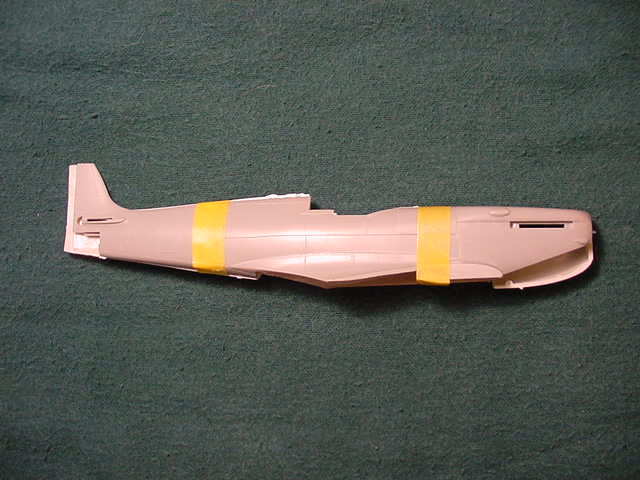 |
|
Hasegawa and Ocidental,
Hasegawa is dark grey. This image shows the shortness of the Hasegawa
fuselage. |
When
you add the rounded tail to the fuselage, the back of the Hasegawa kit becomes 5
mm too short. Add to this that the fuselage is also 1 to 2mm thinner all the way
to the tail.
 |
|
Hasegawa and Ocidental.
Hasegawa is dark grey. The differences in the length and thickness of the
fuselage are shown here. |
The
thrust line of the Ocidental is 2mm too low compared to the Hasegawa kit. The
span of the nicely moulded wing is 37 feet 6 inches verses Ocidental’s 37 feet.
Hasegawa’s wing appears to be more accurate, and Ocidental’s being too broad (by
about 2.5mm). The rudder is slightly broader (1.5mm) in Ocidental’s kit. Having
a nice shape, Ocidental’s prop is 11 feet in diameter (caused by an overly large
spinner, that nose!). The Hasegawa prop is 6” too short in diameter, at 10feet 3
inches.
So
which kit is better? There is no question that the Hasegawa kit is better
detailed and better molded. But the defects in shape with the Hasegawa kit are
very hard if not impossible to fix. When built it does look odd. The shape
errors on the Ocidental kit are easy to correct with the multitude of resin
parts out there. The easier build for a correct Spitfire IXc would be the
Ocidental Mk.IXc.
ICM Compared to Hasegawa
Basically the same problems that the Hasegawa had versus the Ocidental kit, it
has with the ICM kit. The shortness in the tail and nose throws off the
relationship between the wing , fuselage, cockpit and cowl.
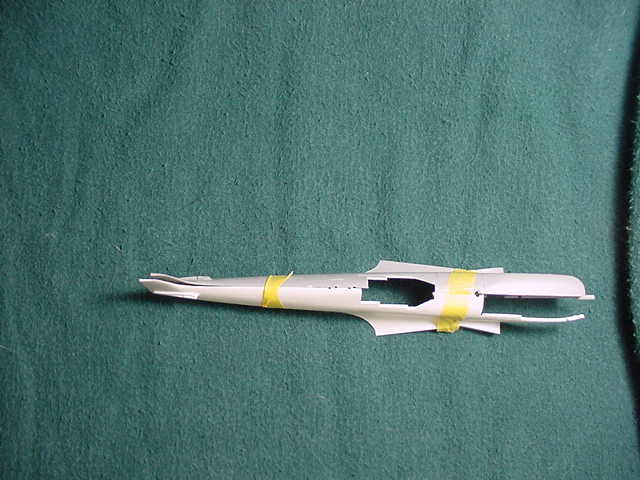 |
|
Hasegawa and ICM. Hasegawa is
dark grey. Top view shows the difference in length and the cockpits. Also
note the positions of the wing fillets, and horizontal stabilizer fillets. |
Hasegawa’s fuselage is also 1mm thinner along the entire length to the tail.
Both wings are nicely shaped, but are slightly to long in span (Hasegawa 37feet
6 inches and ICM 37 feet 9 inches). The rudders are similar with the Hasegawa
slightly better. Hasegawa has better shaped props, but is a scale 6 inches too
small in diameter. ICM’s prop has the proper diameter (10 feet 9 inches) but
the blades are too broad in chord. Lastly the Hasegawa does have the better
interior.
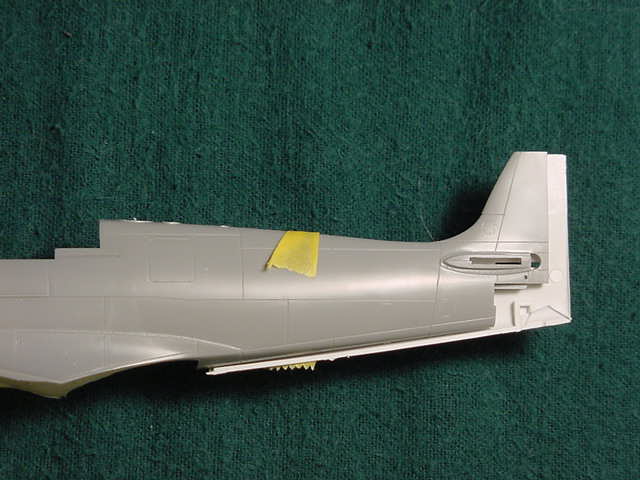 |
|
Hasegawa and ICM, Hasegawa is
grey. Close-up of the tail area showing the difference between the
thickness’ of the two fuselages. |
Which
is better? Hasegawa’s shape errors make it very hard, if not impossible, to do
an accurately shaped Spitfire. The quality of the molding and its detailing does
not save this kit. Though not quite as well molded, the ICM kit is still very
good. Though some detail parts should be replaced (easy to come by), it is more
accurate in outline than either of the other kits. The clear choice here would
be the ICM kit, because of its detailing and better shape.
So after all of
this analysis, what do we have here?
There is a Mk.IX,
which is nicely detailed and molded but shaped out of scale and odd. The second
is molded okay but does have some shape problems. And a third, which is in
scale, nicely detailed but may have some quality control problems.
The first, the
Hasegawa kit, IS molded very nicely and is beautifully detailed. But it has
shape problems, which are very hard to correct, if they can be corrected. That
fuselage being as out of shape as it is distorts the relationship between all of
the major components. These are obvious when placed next to an ICM Mk.IX, as the
Hasegawa looks, well, odd.
The second, the
Ocidental Mk.IXc does have some shape problems, but with sandpaper and some
resin parts these faults are easily corrected.
The third kit
is the ICM Mk.IX. This kit has a very good shape to it, it is in scale, and is
fairly inexpensive to purchase. Yes, some of the parts should be replaced (such
as the wheels and landing gear) but there are a whole bunch of optional parts
(such as bombs, rockets, tails) and 6 decal options. Though a well-known modeler
considers this kit to be junk, it IS the best MkIX as far as accuracy and
scale.
My
recommendations (remember they are MY personal preferences) will certainly cause
a stir, but here they are anyway. If you wish to build a nicely molded kit, and
really do not care for accuracy, then build the Hasegawa. If you want to build
a kit that is fairly easy, and looks fairly good when finished, then build the
Ocidental.
If
accuracy and detailing is what you want then the ICM kit is the only way to go.
|
Selected Scale Measurements |
|
Measurement |
MT417*
|
Hasegawa
|
Ocidental
|
ICM
|
|
Firewall to Cockpit Door Front |
29.1 |
27.8 |
29.0 |
29.5 |
|
Firewall to Cockpit Door Rear |
39.1 |
37.0 |
39.0 |
40.5 |
|
Firewall to Rudder Hinge |
130.9 |
127.0 |
130.5 |
131.0 |
|
Cowl Upper Panel |
42.8 |
42.1 |
43.0 |
42.6 |
|
Cowl Front to Rudder Hinge |
173.7 |
169.0 |
173.5 |
173.5 |
|
Spinner Length |
13.7 |
14.8 |
13.7 |
13.1 |
* MT 417 is a
Spitfire Mk.VIII located at he Cavanaugh Museum in Texas. The 1:1 measurements
were converted into 1/48th scale. Note that all of the
measurements are in millimeters .
|
Acknowledgements and Sources |
Special thanks
to: Joe Lyons and Tom Smith of Southern New Jersey Scale Modelers, Robert
Swaddling, and to Dana D’Amato for the inspiration to write this and for proof
reading this article.
Sources:
Spitfire: The History,
By Eric Morgan and Edward Shacklady, 1993 Key Publishing
Spitfire the Canadians,
By Robert Bracken, 1995 Stoddard Books
Olav Hungnes’ Web Site at
www.uio.no/~hungnes/avia/spitfire/spitfire.htm
Robert Swaddling’s excellent article
about the ICM Spitfire on HyperScale
Spitfire Mk.VIII MT417 located at the
Cavanaugh Aviation Museum in Texas
Tom Cleaver’s Review of the Hasegawa
Spitfire Mk.IX at
http://www.modelingmadness.com/reviews/allies/cleaverspit9preview.htm
Text & Images Copyright ©
2001 by Bruce Archer
Page Created 09 August, 2001
Last Updated
19 April, 2004
Back to Reference Library
|
Home |
What's New |
Features |
Gallery |
Reviews |
Reference |
Forum |
Search